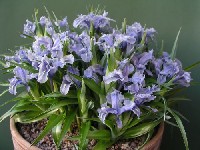Blackpool Show 2005
 Looking across the show benches, it was very obvious that winter still held sway; not only were there intermittent gaps in classes normally heavily entered, but the plants on display were often those whose flowers are normally long since withered or faded by the timing of this Show; among others, Asphodelus acaulis, Cyclamen coum (various representatives from almost cherry pink through to white with red-flushed auricles) Galanthus plicatus, Narcissus cyclamineus (a contender for the Forrest Medal) and Scilla mischtschenkoana were all present in peak of condition.
Looking across the show benches, it was very obvious that winter still held sway; not only were there intermittent gaps in classes normally heavily entered, but the plants on display were often those whose flowers are normally long since withered or faded by the timing of this Show; among others, Asphodelus acaulis, Cyclamen coum (various representatives from almost cherry pink through to white with red-flushed auricles) Galanthus plicatus, Narcissus cyclamineus (a contender for the Forrest Medal) and Scilla mischtschenkoana were all present in peak of condition.
The prevailingly chilly weather meant that one plant seen at all the previous three Shows of the year - a diminutive version of Cyclamen alpinum (Cecilia Coller) with leaves barely larger than a toddler’s fingernail, and correspondingly tiny, though elegantly-formed, vibrant pink flowers held just a couple of centimetres aloft, was awarded the Duncan Lowe Award (ahead of half a dozen rivals) for the best plant in a 19 cm pot. The lime-encrusted leaves of many silver saxifrages are at their most-intense in late winter, and a lusty Saxifraga longifolia (Ian Kidman) gained the Kirby
Cup for the best foliage plant in the Show... though why it was entered in a class for plants ’excluding silver or grey’ was a matter of puzzlement.
Four years on since its last recognition as best plant in Show, a vibrant, full of flower, 30 cm potful of that challenging Syrian juno Iris nusairiensis was clearly the most deserved claimant of the Forrest Medal; already a score or more flowers had been removed, but the 40 plus on display were uniformly at their peak - and there was clearly a further salvo to come. Every other year, the plant is repotted in mid autumn, and any small side growths are detached for distribution to a never-ending queue of would-be recipients.
Some of the most fascinating plants seen were some of the smallest; two of these, both shown by Brian Burrow and both Iranian, were gifts from Dieter Zschummel, over from Germany last year on a lecture tour. Barley 3 cm across, Viola spathulata displayed violet-like, pale lilac/dark-eyed flowers huddled above glaucous, lanceolate leaves, while nearby, the very recently described Dionysia khatamii (seen just once before on the showbench, but not in bloom on that occasion) had a cushion-form aping that of some drastically-reduced D. archibaldii, and flowers that owed their styling not so much to an allied species, but rather to Erinus alpinus.
